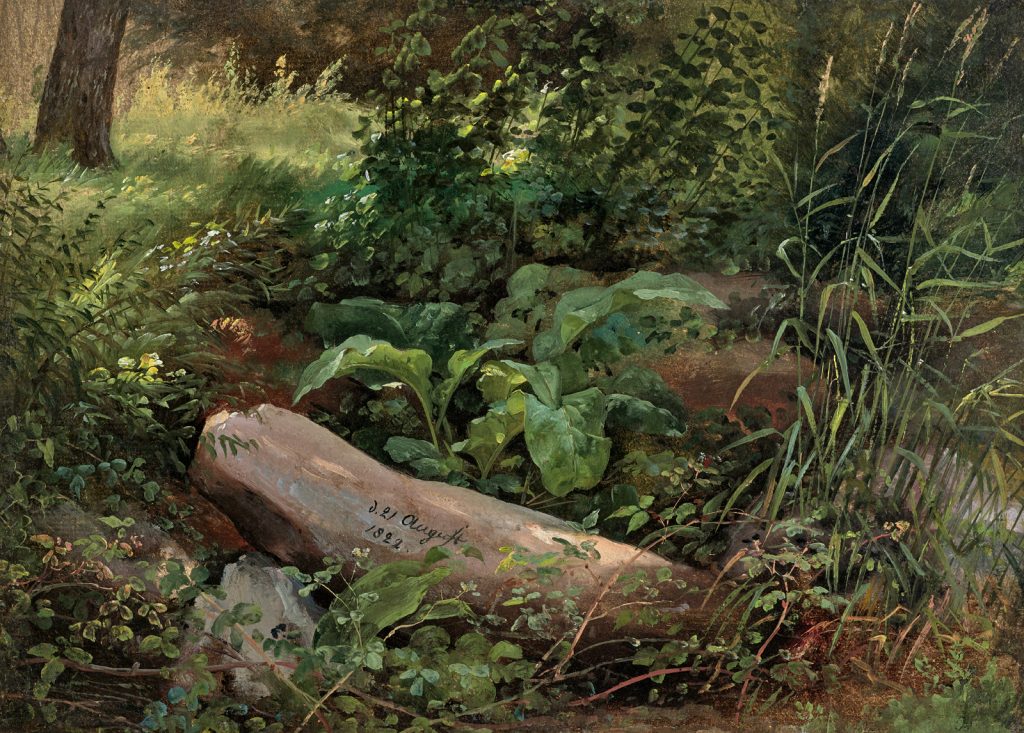Johan Christian Dahl
(Bergen, Norway 1788 - 1857 Dresden)
Lush Undergrowth in the Grand Garden, 1822
Oil on canvas, laid down on cardboard, 25 x 35 cm
Dated lower center d. 21 August / 1822.
Provenance:
J. P. Schneider Jr, Frankfurt;
London, Sotheby's, auction sale, June 2, 2010, lot 238;
Asbjørn Lunde (1927-2017), New York, from 2010, inv. 511.
Exhibited:
Forests, Rocks, Torrents: Norwegian and Swiss Landscapes from the Lunde Collection, London, National Gallery, 2011, no. 15;
Sublime North: Romantic Painters Discover Norway. Paintings from the Collection of Asbjørn Lunde, Hartford, Wadsworth Atheneum Museum of Art, September 2017-January 2018.
I prefer to depict nature in its free, untamed condition, and to work in areas of mighty rock formations and dense forest; for that reason I am not entirely content here either [in Dresden]; while in some ways there is great beauty in nature [here], it nevertheless seems of somewhat inferior value, one finds too many traces of human hand. (Dahl in a letter to the Danish Crown Prince, Christian Frederik, dated 26 November 1818).
On his return from Italy in the summer of 1821, Johan Christian Dahl repeatedly turned his attention to the landscapes of Dresden, his adoptive home, to enrich his repertoire of motifs. He was attracted by subjects such as the Großer Garten, the city’s baroque park; the high, sloping banks of the river Elbe; the valley of the Plauenscher Grund; and the hilly area south-east of Dresden known as the Sächsische Schweiz. The oil studies he produced here are highly distinctive, beautifully rendered impressions of nature. They capture the topography of the region, and convey prevailing weather conditions and specific effects of light with extraordinary immediacy.
The Großen Garten lies south-east of the city of Dresden. Originally established in 1676 by order of Johann Georg III, Elector of Saxony, it underwent considerable enlargement in the course of its history. It suffered severe damage in 1760 during the Seven Years’ War and again in 1813 at the time of the Napoleonic Wars. It was redesigned in the style of an English landscape garden in 1814 and opened to the public. Dahl is known to have enjoyed painting and sketching in the Großer Garten. In a diary entry, he described a painting excursion in 1818: ‘On Wednesday evening the weather was glorious. The landscapist Friedrich and I took a long walk in the Großer Garten on the outskirts of the city; it is planted with a splendid, very diverse assortment of the finest trees.1
This oil study is inscribed in the image with the exact date of execution – August 21, 1822. It depicts an area of dense undergrowth in the Großer Garten. The reeds shown at the right indicate that the ground is damp. Dahl’s interest focuses on the sunlight glinting on the foliage and the tree trunk, the play of light on the lush green leaves. The existence of two further studies executed in the Großer Garten one day later has helped to situate the motif. They are dated 22. August 1822 (Bang 385 and 386).2 The present study bears a date but is unsigned. This is not unusual for Dahl. Distinct orthographic similarities in the dating of all three studies confirm the authenticity of the present study.
1 Cited after Jan Drees, ‘Johan Christian Dahl und sein Weg zur Natur’, in Wolken Wogen Wehmut, Johan Christian Dahl 1788-1857, exhib. cat., Schleswig, Schloss Gottdorf, Stiftung Schleswig-Holsteinisches Landesmuseen, Munich, Haus der Kunst, 2002, p. 17.
2 Marie Lødrup Bang, Johan Christian Dahl, 1788-1857. Life and Works, catalogue raisonné, Oslo 1987, II, p. 139, nos. 385 and 386.

